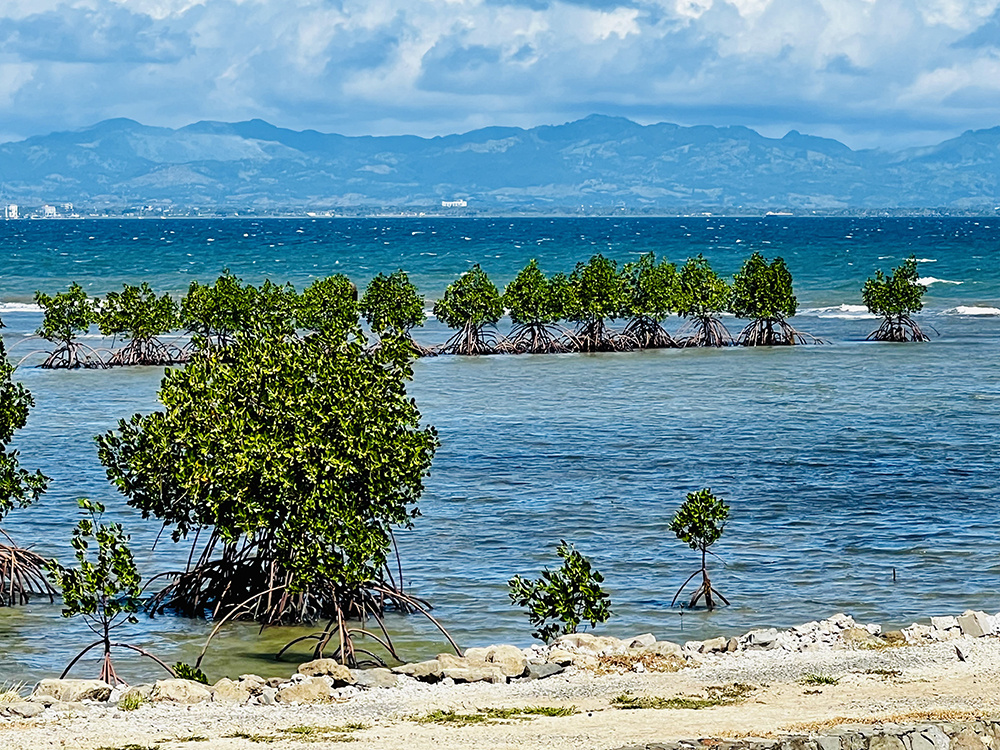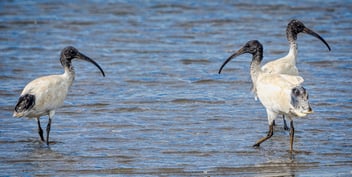New floating mangrove pontoon research partnership launches in Fiji

A ground-breaking mangrove research and rejuvenation program has been launched in Suva, Fiji, with the project set to develop and pilot floating mangrove pontoons and undertake environmental restoration in partnership with local communities along the coast of Viti Levu.
Intense storm surges threaten the propagation of mangroves, but the floating mangrove pontoons offer a nature-based solution that aims to decrease the destructive effect of storm surges on coastlines, while also promoting the growth of mangroves for ecosystem services.
With support from Swire Shipping and led by UNSW’s Dr Andrew Dansie and Professor Will Glamore, Project Halophyte is a collaboration between UNSW Sydney, the University of the South Pacific (USP), the Fiji Government, with The Pacific Community (SPC), and UNESCO.
Dansie said Project Halophyte’s partnerships will enable the research innovation and large-scale intervention needed to address the environmental degradation that is becoming a huge problem for the planet.
“We are so thankful to Swire Shipping and the Fijian Government for backing this important project in support of the growing ambition among Pacific nations to tackle climate change,” he said.
“From a scientific standpoint, we are looking at mangroves in the Fijian context and how the methodologies developed in Australia can be transferred. Fiji is the perfect place to demonstrate the research and then scale it up.
“Research plays a big role in addressing some of these challenges. Doing this work in partnership is critical if we are going to create truly sustainable solutions. Working with Fiji and empowering the next generation of research is something we are really excited to be part of.”
Glamore said UNSW, USP and Swire Shipping have come together in support of a project with a sustainable vision for the future of the Pacific using nature-based solutions.
“This is a partnership. Collaboration is a big part of the work, in line with how any work that is conducted in the Pacific should be approached,” he said.
Fiji’s Assistant Minister in the Office of the Prime Minister, the Hon Sakiusa Tubuna, said the research partnership represents a positive step towards mitigating the impacts of climate change while battling its causes simultaneously.
“The futuristic vision behind this partnership is set to not only benefit Fiji as the pilot country but also have a positive impact across the region,” he said.
Why mangroves?
Globally, many coastal environments have been degraded due to human activities and climate change. In Fiji, as in many parts of the world, human activities have reduced the coastline’s natural functions and biodiversity.
Glamore said that, while work to restore coastal wetlands has been occurring for decades, success rates are still low: “There are alot of projects out there that have a 70-90% failure rate. And that is not good enough”.
“When we are restoring coastal wetlands, we are restoring the tidal flats, the mangroves and the salt marsh. We want to make sure any project we undertake is successful. And the key ingredient to success is getting the mangroves right,” he said.
“We study mangroves for all the great ecosystem services they provide – including habitat, carbon sequestration and water quality – but they are also part of border coastal wetland systems, too.
“Mangroves are really the first buffer between us and the ocean – they’re crucial in terms of providing attenuation of flooding and storm surges, while holding the land in place. If we want these buffers to remain, we need to restore mangroves and keep them in place.”
Glamore said the project will prioritise mangrove restoration, focusing on novel rejuvenation methods and nature-based engineering solutions across coastal, urban and agricultural lands.
“We have a lot of experience in restoring coastal wetlands and mangroves, and that work is about understanding how mangroves grow from a tiny propagule to a big tree. This includes understanding different life phases of the mangrove,” he said.
“One of the biggest threats are waves coming through the system. We are getting stronger storm surges, which means that little propagules get submerged or washed away.
“The aim of this nature-based solution is to reduce wave energy but also create a better place for mangroves to grow.”
Key aims
There are three main aims in this research, Glamore said, the first being to nurture the next generation of mangrove research in the Pacific.
“We want to support the growth of a huge amount of knowledge on mangroves in the Pacific that can be passed on to the next generation. Through that, the work will continue forward. We want to create a sustainable industry that will encourage more mangrove restoration,” he said.
“The next aim is to bring nature on to other structures. We are hoping to create a whole range of nature-based solutions through this project that can then be rolled out across different contexts.”
Dansie said the third aim of the research is to measure the economic, social and environmental (ESG) improvements of these types of large-scale restoration projects in support of nurturing healthier and more resilient communities and incorporating the extensive existing traditional knowledge base.
“Even though the restoration will be occurring in a narrow fringe of habitable land where mangroves can grow around the northwest coast of Viti Levu, the impacts to people are expected to occur across a larger area. We want to capture those impacts,” he said.
“In the Pacific, none of the Sustainable Development Goals will be reached by 2030. A big part of the project is to measure these ESG indicators and assess how these large scale nature-based solutions can help.
“One thing we are very keen on assessing very closely is the benefits in livelihood that this work fosters within communities without putting additional pressure on freshwater resources. We are supporting the Fiji Government to be able to showcase that mangroves can be part of the way forward.”
Global application
Project Hylophyte developed through UNSW’s Global Water Institute collaboration with UNESCO and active engagement of UNSW’s Humanitarian Engineering Program in the Pacific, and now has funding to implement real-world pilot models.
“We have been deeply involved with developing the blue carbon methodology in Australia and there have been a lot of lessons learned. If we can share those lessons, we might be able to assist other countries in doing this work effectively the first time around,” Glamore said.
“The University of South Pacific is based in eight different countries. They are a multinational university. We’d love to see the work expanded and implemented in many areas.
“There are dozens of villages in Fiji that are currently earmarked for evacuation due to climate change. If we can bring nature-based solutions that make a significant difference to Fiji and the Pacific, there’s no reason why it can’t also be applied everywhere.”


